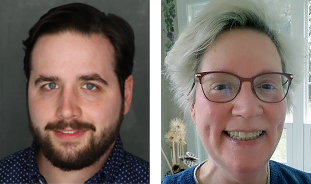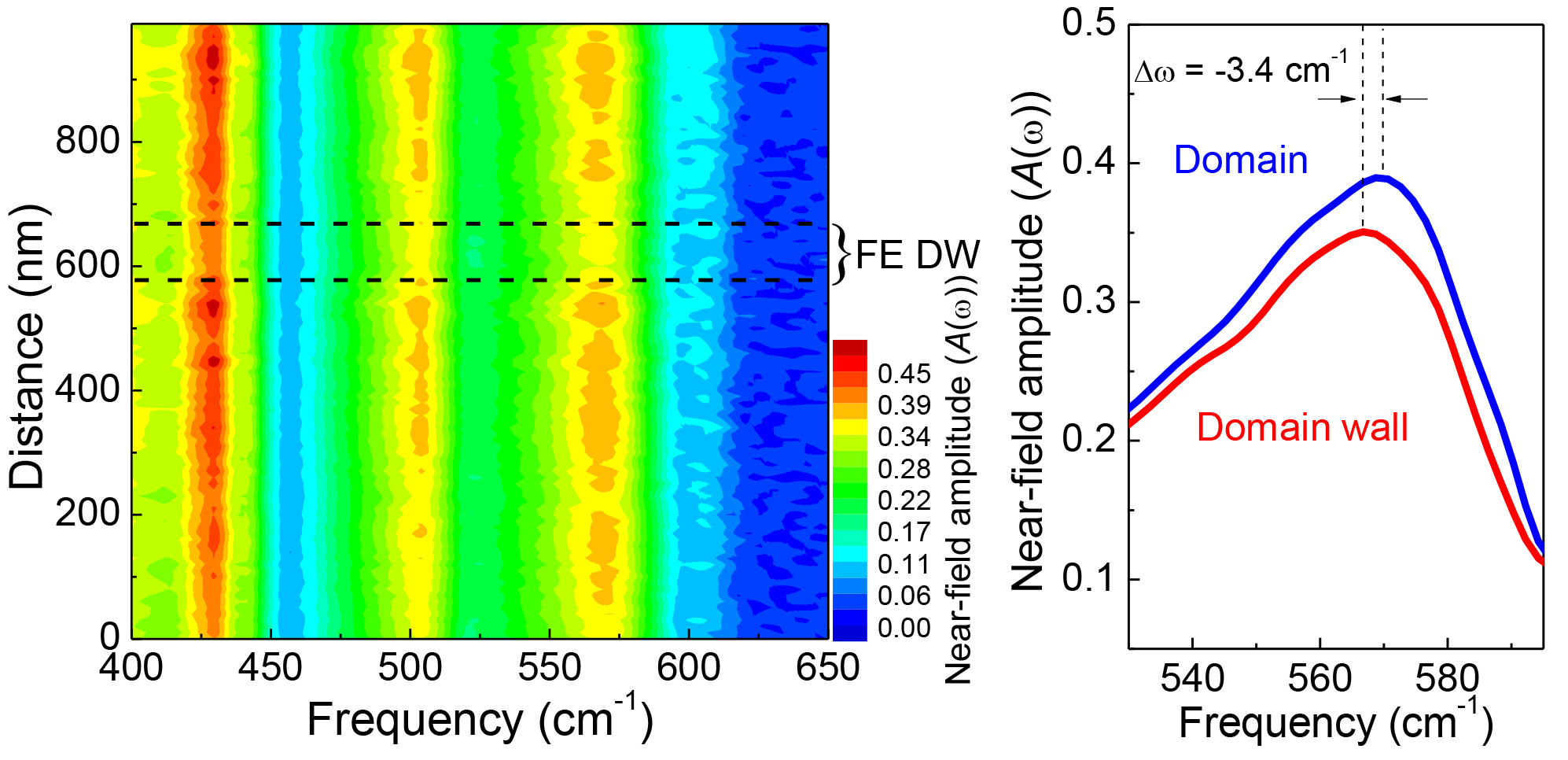SCIENTIFIC ACHIEVEMENT
Researchers used infrared light from the Advanced Light Source (ALS) to investigate the properties of the domain walls that separate electrically polarized (ferroelectric) regions in a rare-earth ferrite material.
SIGNIFICANCE AND IMPACT
An understanding of domain-wall behavior is relevant to the development of advanced logic and memory applications for ultralow-power digital devices.

Bit-flipping studies hit a wall
In materials with lattice structures that are slightly askew, a net separation of positive and negative charges can arise—i.e., tiny electric dipoles with both magnitude and direction. By analogy to electron-spin alignment in ferromagnets, a “ferroelectric” material is one where these electric dipoles spontaneously align. The alignments occur in domains that could serve as digital bits, subject to being flipped by an external electric field. Such materials are of great interest to scientists for fundamental reasons as well as for use in next-generation logic and memory applications that consume very little power.
Recent studies have highlighted the importance of understanding what happens at the walls separating polarized domains. Because polarization flipping modifies domain patterns, the domain walls must accommodate this change. Moreover, in materials with both ferroelectric and ferromagnetic order (multiferroics), local conductivity and coupling between orders—both of which could be useful in devices—have been observed at the domain walls. However, the lack of experimental techniques with sufficient resolution has meant that domain-wall characteristics have remained largely underexplored.

In this work, researchers used infrared nanospectroscopy at the ALS to probe lattice vibrations (phonons) across ferroelectric domain walls. The work opens the door to studies of physical and chemical heterogeneity in ferroics and represents an important step toward revealing the rich and potentially useful properties hidden within domain walls.
Synchrotron infrared nanospectroscopy
Vibrational spectroscopies, such as those in the infrared regime, are well-suited for unveiling the phonons that drive polar displacements. The challenge is that infrared light has a long wavelength and cannot be focused below about 20 µm2 (the “diffraction limit”). Synchrotron-based near-field infrared nanospectroscopy overcomes the diffraction limit and provides the high sensitivity and 20 nm2 spatial resolution needed to image samples with nanoscale textures or small lateral areas.
In this work, synchrotron-based near-field infrared nanospectroscopy was performed at ALS Beamline 2.4 on samples of the rare-earth ferrite, Lu0.6Sc0.4FeO3. The undoped material, LuFeO3, typically has an orthorhombic structure. Replacing some of the Lu with Sc (a smaller and lighter rare-earth element) leads to a more compact, hexagonal structure that hosts ferroelectric domains at room temperature. The researchers then compared their results with detailed symmetry analyses, lattice dynamics calculations, and prior models of domain-wall structure.
Boundary conditions
The results revealed that the ferroelectric walls have significant width (on the order of 100 nm), a conclusion that contradicts the traditional view that ferroelectric domain boundaries are atomically thin interfaces. Another unexpected result is that the walls in hexagonal Lu0.6Sc0.4FeO3 are semiconducting rather than conducting.
Finally, the results begin to tease out subtle frequency shifts at the domain walls, in both bending and stretching modes, that were previously predicted but never observed because they were below the sensitivity of earlier methods. The shifts are consistent with the appearance of an intermediate (possibly nonpolar) phase internal to the wall, in line with proposed models.
Opportunities to build upon these findings include exploring domain walls in other materials, enhancing and controlling properties with compositional tuning, and developing the structure-property relations among ferroelectric walls in related multiferroics.

Contact: Jan Musfeldt
Researchers: K.A. Smith and J.L. Musfeldt (Univ. of Tennessee, Knoxville); S.P. Ramkumar and E.A. Nowadnick (Univ. of California, Merced); K. Du, X. Xu, and S.-W. Cheong (Rutgers Univ.); and S.N. Gilbert Corder and H.A. Bechtel (ALS).
Funding: National Science Foundation; Gordon and Betty Moore Foundation; and U.S. Department of Energy, Office of Science, Basic Energy Sciences program (DOE BES). Operation of the ALS is supported by DOE BES.
Publication: K.A. Smith, S.P. Ramkumar, K. Du, X. Xu, S.-W. Cheong, S.N. Gilbert Corder, H.A. Bechtel, E.A. Nowadnick, and J.L. Musfeldt, “Real-Space Infrared Spectroscopy of Ferroelectric Domain Walls in Multiferroic h-(Lu,Sc)FeO3,” ACS Appl. Mater. Interfaces 15, 7562 (2023), doi:10.1021/acsami.2c19600.
ALS SCIENCE HIGHLIGHT #481